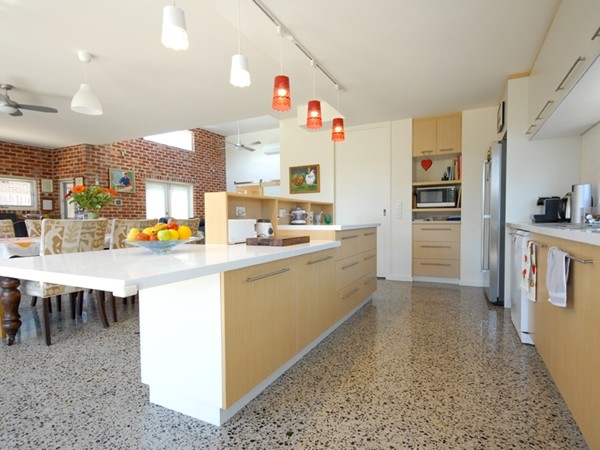

Reverse brick veneer case study: Solar Sellew by Positive Footprints
A material case study of a 9-star NatHERS rated residential project based in Victoria reveals a lot about reverse brick veneer and BioPCM phase change materials.The following case study focusses on the wall composition in a 9-star 'Nationwide House Energy Rating Scheme' (NatHERS) rated residential project in Victoria.
The case study follows a separate article with the designer, Jeremy Spencer, Director of the Melbourne-based firm, in which he details expert insights on lightweight versus heavyweight wall construction approaches, including on the reverse brick veneer walling system that his firm uses for their low-energy residential projects.
PROJECT: Solar Sellew by Positive Footprints
Method: “mass and glass”
Performance Rating: 9-star rating on Nationwide House Energy Rating Scheme (NatHERS)
Bottom floor walls: reverse brick veneer
Top floor walls: reverse brick veneer and BioPCM phase change materials

DESIGN PROCESS
Firstly Spencer drew the basic concept through the prism of passive solar design which considers the shading, sunlight and cross ventilation of all the rooms in the house. He then moved onto detailed assessments of each room with the aid of a software system.
“While the design is still quite fluid –before we have done working drawings and engineering—we submit it to an energy assessment software program called AccuRate which was developed by the CSRIO and recognised by the Building Code of Australia,” he explained.
“The software we use is really powerful in that it zones each room of the house and will give you temperature and wind predictions at different times of the year using 30 years of climatic data for area.”
“Because we use different wall types and construction techniques outside of the norm, the AccuRate system allows you to make up your own wall segments; choose different wall thicknesses and materials etc.”
“The great thing about doing that rating early is that you can look at two different rooms in the house and see why what’s happening in one isn’t happening in the other, and you can start to play with variables such as windows and mass or even eave size and compensating for tree shade.”
MATERIALS
External Skin: Stratco Maxirib and James Hardie Easylap Panels

“As a general rule we use lightweight cladding on the outside because per square metre they are usually less costly than brick, block, or even lightweight Hebel and they have less embodied energy,” said Spencer.
“We chose James Hardie Easylap because the house could be easily configured to work around its size (90mm) so there was less waste.
“All the windows are either 900, 1800 or 2700mm so they fit in easily and the cladding can go up reasonably quickly as well.
“It’s part of their Scyon family and they have taken the time and effort to do life-cycle assessments and use recycled materials.
“They also have low embodied energy and are more stable, and paint adheres to them better so you get longer span between coats.
Cavity: reflective foil and Fletcher Sonobatt insulation
“Insulation must be on the outside of the thermal mass otherwise, like your typical brick veneer, it is really just a cladding and has no thermal benefit.” Jeremy Spencer, Positive Footprints. (Image: Mirvac)
Spencer explains that typically he will batten out the lightweight cladding by 20mm with timber or steel and attach reflective foils to the face of the studwork.
“Because the foil faces on to the 20mm air gap it gives it a slight .5 R-value and also stops water ingress,” he explained.
The 90mm structural framing pine is then insulated with Fletcher Sonobatt which Spencer says has an R-Value of 2.7 and is also very good at stopping sound.
“We then have a small 15-20mm space and then we have the recycled brick, the still air gap again gives a .5 R value but also gives the bricklayer some space so he isn’t skinning his fingers,” he explained.
“That’s a practical side of it.
Internal Skin: recycled bricks

Spencer uses recycled bricks as the internal skin of Solar Sollew because of their thermal mass and embodied energy.
“As a general rule, the more mass inside of your insulation, the more stable your internal temperature will be.”
*A brick’s embodied energy is lowered once it is recycled.
UPSTAIRS: BioPCM phase change material.

Image: Kevin Hagen for The Wall Street Journal
“When we did the energy modelling upstairs, we had the issue that, like in most double storey buildings, the heat was rising and warming the second storey rooms too much,” explained Spencer.
“We have some RVB walls that continued up, but when there was no platform for walls to build-up from, we used a product called BioPCM.
“It’s a lightweight phase change material that looks like bubble wrap and works a bit like thermal mass.
“Everything is effectively the same as a reverse brick veneer system but instead of bricks we have the phase change material that sits inside the cavity and behind plasterboard internal wall.
“On the inside of the studwork you put the material with the bubbles facing in and then you put the plasterboard over the top of that.
“The materials inside the phase change packets melt at room temperature – in this case 23 degrees—and will continue to melt as heat enters the room.”
“Because it takes energy as to change phases –from solid to liquid—what will happen is that it will heat up normally to 23 degrees and then as more heat comes in through the window, instead of going to 24 it will start melting and absorb that heat’s energy.
“As more heat comes in it will continue to melt until all the material is melted and then the room will finally rise in temperature to 24.”
“We have calculated to put enough of the product in so that on any one given day the sun has set before it has all melted – effectively we put a cap temperature on it.
- Popular Articles




